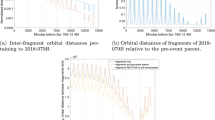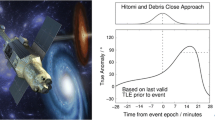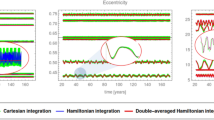Abstract
The breakup of the Spot 1 Ariane third stage rocket was one of the most prolific and puzzling satellite fragmentation events ever. The cause of the breakup was long listed as unknown, with several studies pointing to different conclusions. This study re-examines the breakup by studying the velocity distribution patterns of the fragments. The presence of six fragments in high energy orbits suggests collision as a possible cause of the breakup. The existence of butterfly patterns in the spread velocities of the fragments in planes between the vertical and the downrange directions also points to fragmentation by impact. The orientations of the debris concentrations flanking the high energy ricochet uncovers the possible path of the projectile that could have struck the Ariane rocket—the projectile could have come from an angle of 11° or less above the horizontal and about 6° from the left of the Ariane’s path. The velocity perturbations distributions in the radial and downrange components show that fragments lying outside the Gaussian envelopes comprised the high energy ricochet and ejecta which emanated from the contact area. Both of the Gaussian envelopes exhibited displacements opposite from the ricochet and ejecta, thus betraying recoil effects. The cross-range velocity distribution pattern was severely distorted with the ejecta forming concentrations on either side of the Gaussian envelope—a further sign of possible collision. Finally, a cluster analysis of the fragments indicates that the vast majority of the fragments suffered only small velocity changes while the high energy ricochet and ejecta formed their own distinct clusters, which is yet another indication of possible fragmentation by impact. The possible path of the projectile would place itself among the members of the Sun-synchronous orbiting group.
Similar content being viewed by others
References
JOHNSON, N., WHITLOCK, D. O., ANZ-MEADOR, P., CIZEK, M. E., and PORTMAN, S. A. History of On-Orbit Satellite Fragmentation (13th Ed.), NASA Johnson Space Center, 2004.
“Investigation of Delta Second Stage On-Orbit Explosions,” McDonnell Douglas Astronautics Co. Document MDC-H0047, Huntington Beach, California, 1982.
JOHNSON, N. L. “Artificial Satellite Break-Ups (Part 1): Soviet Ocean Surveillance Satellites,” Journal of British Interplanetary Society, Vol. 36, 1983, pp. 51–58.
KLING, R. “Postmortem of a Hypervelocity Impact,” Teledyne Brown Engineering Report, CS86-LKD-001, Colorado Springs, Colorado, 1982.
JOHNSON, N. L. “Artificial Satellite Break-Ups (Part 2): Soviet Anti-Satellite Program,” Journal of British Interplanetary Society, Vol. 36, 1983, pp. 357–362.
Technical Report on Space Debris, United Nations, New York, 1999.
JOHNSON, N. “First Natural Collision of Cataloged Earth Satellite,” The Orbital Debris Quarterly News, Vol. 1(2), 1996, p. 1.
“A New Collision in Space?” The Orbital Debris Quarterly News, Vol. 7(3), 2002, p. 1.
CULP, R. D. and MCKNIGHT, D. S. “Distinguishing Between Explosion-Induced and Collision-Induced Breakups Through Debris Analysis,” AAS/AIAA Astrodynamics Specialist Conference, Vail, Colorado, August 1985.
MCKNIGHT, D. S. “Discerning the Cause of Satellite Breakups,” American Association for the Advancement of Science Meeting, April 1986.
MCKNIGHT, D. S. “Analysis of the 1981–53 Breakup Event,” SDIO/IST Second Pathways to Space Experimentation Workshop, Orlando, Florida, June 1986.
MCKNIGHT, D. S. “Simulation of Satellite Breakups,” presented as paper AIAA-86-2220 at the AIAA/AAS Astrodynamics Specialist Conference, Williamsburg, Virginia, August 18–20, 1986.
MCKNIGHT, D. S. “Determining the Cause of a Satellite Breakup: A Case Study of the Kosmos 1275 Breakup,” IAF Congress, Brighton, England, October 1987.
BESS, T. D. “Mass Distribution of Orbiting Man-Made Space Debris,” NASA Technical Note D-8108, Langley Research Center, 1975.
NEBOLSINE, P. E., LORD, G. W., and LENGER, H. H. “Debris Characterization Final Report,” Physical Sciences Inc. Report For Contract DAS G60-84-C-0005 from Teledyne Brown Engineering, 1983.
KESSLER, D. J. and COUR-PALAIS, B. “Collision Frequency of Artificial Satellites: The Creation of a Debris Belt,” Journal of Geophysical Research, Vol. 83, 1972, pp. 2637–2646.
TAN, A. “Analysis and Interpretation of Satellite Fragmentation Data,” in NASA Report CR-172009, 1987.
BADHWAR, G. D., TAN, A., and REYNOLDS, R. C. “Velocity Perturbations Distributions in the Breakup of Artificial Satellites,” Journal of Spacecraft and Rockets, Vol. 27, 1990, pp. 299–305.
JOHNSON, N. L. “A Preliminary Analysis of the Fragmentation of the Spot 1 Ariane Third Stage,” Teledyne Brown Engineering Report CS87-LKD-003, Colorado Springs, Colorado, 1987; also in Orbital Debris from Upper Stage Breakup, J. P. Loftus, Jr. ed., AIAA, Washington, 1989.
COUR-PALAIS, B. G. and CREWS, J. L. “Hypervelocity Impact and Upper Stage Breakups,” in Orbital Debris from Upper Stage Breakup, J. P. Loftus, Jr. ed., AIAA, Washington, 1989.
HENIZE, K. G. and RAST, R. H. “Potential Spot-1 R/B — Cosmos 1680 R/B Collision,” in Orbital Debris from Upper Stage Breakup, J. P. Loftus, Jr. ed., AIAA, Washington, 1989.
KESSLER, D. J. “Current Orbital Debris Environment,” in Orbital Debris from Upper Stage Breakup, J. P. Loftus, Jr. ed., AIAA, Washington, 1989.
JOHNSON, N. L. “Evolution of the Artificial Earth Satellite Environment,” in Orbital Debris from Upper Stage Breakup, J. P. Loftus, Jr. ed., AIAA, Washington, 1989.
CHOBOTOV, V. “Classification of Orbits with Regard to Collision Hazard in Space,” Journal of Spacecraft and Rockets, Vol. 20, 1983, pp. 484–490.
BENZ, F. J., KAYS, R. L., BISHOP, C. V., and ECK, M. B. “Explosive Fragmentation of Orbiting Propellant Tanks,” in Orbital Debris from Upper Stage Breakup, J. P. Loftus, Jr. ed., AIAA, Washington, 1989.
JOHNSON, N. L. “The Collision of Satellites 16937 and 16938,” Teledyne Brown Engineering Report CS87-LKD-001, Colorado Springs, Colorado, 1986.
TAN, A., BADHWAR, G. D., ALLAHDADI, F. A., and MEDINA, D. “Analysis of the Solwind Fragmentation Event Using Theory and Computations,” Journal of Spacecraft and Rockets, Vol. 33, 1996, pp. 79–85.
TAN, A. “Ricochet Fragments: A Sufficient Condition for Collision in Space?” Orbital Debris Monitor, Vol. 9(3), 1996, pp. 4–7.
TAN, A. and ZHANG, D. “Analysis and Interpretation of the Delta 180 Collision Experiment in Space,” The Journal of the Astronautical Sciences, Vol. 49, 2001, pp. 585–599.
MEIROVITCH, L. Methods of Analytical Dynamics, McGraw-Hill Book Co., New York, 1970.
ZOTKIN, I. T. and TSIKULIN, M. A. “Simulation of the Tungus Meteorite,” Soviet Physics Doklady, Vol. 11, 1966, pp. 183–186.
BADHWAR, G. D., POTTER, A. E., ANZ-MEADOR, P. D., and REYNOLDS, R. C. “Characteristics of Satellite Breakups from Radar Cross-Sections and Plane Change Angle,” Journal of Spacecraft and Rockets, Vol. 25, 1988, pp. 420–426; also in Orbital Debris from Upper Stage Breakup, J. P. Loftus, Jr. ed., AIAA, Washington, 1989.
TAN, A., ALLAHDADI, F., MAETHNER, S., and WINTER, J. “Satellite Fragmentation: Explosion vs. Collison,” Orbital Debris Monitor, Vol. 6(2), 1993, pp. 8–13.
TOU, J. T. and GONZALEZ, R. C. Pattern Recognition Principles, Addison-Wesley, Reading, Massachusetts, 1974.
Author information
Authors and Affiliations
Rights and permissions
About this article
Cite this article
Tan, A., Ramachandran, R. Velocity Perturbations Analysis of the Spot 1 Ariane Rocket Fragmentation. J of Astronaut Sci 53, 39–50 (2005). https://doi.org/10.1007/BF03546393
Published:
Issue Date:
DOI: https://doi.org/10.1007/BF03546393




